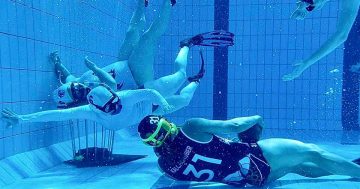
Athletics coach Tudor Bidder at the Australian Institute of Sport running track. Photo: Supplied.
By his own admission, Tudor Bidder was a failed 400-metre hurdler. The Welshman missed selection for the 1982 Commonwealth Games in Brisbane, but this setback allowed him to switch his focus to coaching, a profession where he has made a lasting impact on the lives of many track and field athletes.
Tudor first came to Australia as a coach at the Western Australian Institute of Sport in the early 1990s. At the time, he was one of a number of high-profile overseas coaches employed by the Australian Institute of Sport (AIS).
Other notable coaches at the time included swimming coach Gennadi Touretski, who joined the AIS after the 1992 Olympic Games in Barcelona. Two years earlier, Heiko Salzwedel had set up the AIS road cycling program.
Heiko died in Germany just last month. Many cyclists in Australia thrived under his guidance.
Both Gennadi and Heiko, along with Tudor, had an enormous influence on Australian sport.
By 2003, the AIS athletics program hadn’t won a medal at a world championship level since the 2000 Olympics, when Jai Taurima won silver in Sydney.
In a bid to find a solution, Tudor was appointed as high performance manager of the Athletics Australia/AIS program in Canberra.
“We had a lot of bodies but not much output,” he recalls.

Tudor Bidder with former sprinter Patrick Johnson. Photo: Supplied.
But Tudor presented a strong direction.
“The main thing we needed to do was target events in which we had been historically good at,” he says. “Disability athletes, in particular.
“Also, walking was regarded as ‘out of sight, out of mind’ but we wanted to create a better pathway for walkers.”
Tudor says the aim was to change the perception of the Canberra-based AIS program in a bid to attract top athletes.
“There was an anti-Canberra campaign from athletes, some of who thought it was too far from the beach.”
This created a major hurdle as Tudor operates on the premise of “athletes working off each other”.
To combat the negative perception of Canberra, Tudor and his team created a high-performance environment, which became attractive to athletes such as Olympic walking gold medallist Jared Tallent, who emerged from the program and won gold in London in 2012.
The program closed when the Winning Edge strategy of prioritising funding towards sports with the highest chance of success was introduced. Tudor felt an opportunity was lost.
“I thought we were riding a wave at that time, but with the introduction of Winning Edge, individual sports organisations had greater control over funding, and track and field was dispersed,” he says.
“People who had invested time and effort moved away.”
In more recent times, Tudor was working at the AIS as senior performance consultant in the area of sport strategy.
He left the AIS in May to return to the coalface of ‘hands on’ high-performance sports coaching and helping other coaches.
“I am keen to become involved in coaching teams, such as relays,” he says.
At 64 years of age, Tudor has a new lease of life. His years of experience will once again rise to the surface for the benefit of track and field sport in Australia.



















